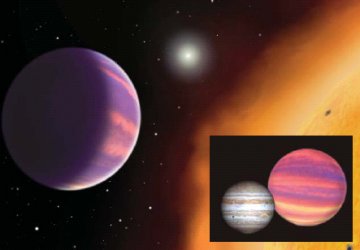A Puffy Planetary Puzzle
Astronomers spot an unusual object orbiting a nearby star.
By Eric Jaffe
Astronomers recently made a fuss about Pluto, saying that it’s not really big enough to be called a planet (see “Pluto and the Plutons”). Now, they’re making a fuss about a planet that might be the largest one yet discovered.
 |
|
In this artist’s illustration, a newfound planet closely orbits a star that’s just 450 light-years from Earth. A partner star (top center) lies in the distance. The inset compares Jupiter (left) with the puffy planet, HAT-P-1b (right).
|
| D. Aguilar |
The newfound planet is called HAT-P-1b. It’s 450 light-years from Earth and 36 percent wider than Jupiter, which is the largest planet in our solar system.
HAT-P-1b circles its parent star very closely—much more closely than Earth circles its own parent star, the sun. It also has a surprisingly low density. Although it’s bigger than Jupiter, it has only half of Jupiter’s mass. That makes it a puffy giant.
The density of HAT-P-1b is the lowest of any known planet, says codiscoverer Robert Noyes of the Harvard-Smithsonian Center for Astrophysics in Cambridge, Mass.
That’s very unusual for a planet, especially one that orbits its star so closely. “We have a bit of a puzzle,” Noyes says.
Astronomers found HAT-P-1b using six small, robotic telescopes. Four of the telescopes are at the Whipple Observatory in Arizona, and the other two are in Hawaii.
They detected the planet because, while orbiting, it passes directly between Earth and its parent star, the fainter member of a double-star system called ADS 16402. Each time it does this, the planet blocks a little bit of the star’s light reaching Earth.
HAT-P-1b is an extrasolar planet, which means it exists outside our solar system. It’s one of about 200 extrasolar planets that astronomers have discovered so far.
Only one other extrasolar planet has a density nearly as low as that of HAT-P-1b. Originally, some astronomers had considered this planet a fluke. Now, they have to take more seriously the idea that puffy, hot supergiants may not be that rare.—E. Jaffe
Going Deeper:
Cowen, Ron. 2006. Oversize orb: Puffy planet poses puzzle. Science News 170(Sept. 16):181. Available at http://www.sciencenews.org/articles/20060916/fob5.asp .
Sohn, Emily. 2006. Pluto and the plutons. Science News for Kids (Aug. 23). Available at http://www.sciencenewsforkids.org/articles/20060823/Note3.asp .
______. 2005. Cousin Earth. Science News for Kids (June 29). Available at http://www.sciencenewsforkids.org/articles/20050629/Note2.asp .
______. 2004. A very distant planet says “cheese.” Science News for Kids (Sept. 22). Available at http://www.sciencenewsforkids.org/articles/20040922/Note2.asp .
______. 2004. Planet hunters nab three more. Science News for Kids (Sept. 8). Available at http://www.sciencenewsforkids.org/articles/20040908/Note2.asp .
______. 2003. A planet’s slim-fast plan. Science News for Kids (March 19). Available at http://www.sciencenewsforkids.org/articles/20030319/Note2.asp .







